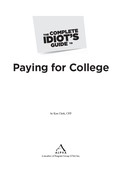Other Major Federal Grants
Although the Pell Grant is the 800-pound gorilla of federal grants, it’s by no means the only game in town. In fact, a number of other substantial grants might be available on top or in place of the Pell Grant. Most of these programs are designed primarily for undergraduate students earning their first college degrees, although some are designed for or can be used by graduate students.
The Academic Competitiveness Grant
The Academic Competitiveness Grant (ACG) is awarded only to students who are also eligible for a Pell Grant. It’s essentially a bonus grant for Pell Grant recipients who have demonstrated they can handle academic rigor by passing a certain amount of core classes in high school or by maintaining at least a 3.0 in their freshman years of college.

CHEAT SHEET
If you have one or more students who still have a couple of years left of high school, you can greatly increase your chances of qualifying for the Academic Competitiveness Grant by taking certain classes. The current requirements include four years of English; three each of math, science, and social studies; and one year of a foreign language.
The maximum ACG grant for someone’s freshman year of college is $750, with a maximum of $1,300 being awarded in a student’s sophomore year. No awards are made for junior year or later. Eligible students who file a Free Application for Federal Student Aid (FAFSA) form will automatically be notified if they’re eligible to receive the ACG grant. If eligible, a student must provide additional information and documentation to her college of choice to complete the award process.
The Federal Supplementary Educational Opportunity Grant
The Federal Supplementary Educational Opportunity Grant (FSEOG) is awarded to students demonstrating an extreme financial need. In other words, you’re probably not going to get this unless your EFC is zero. But, if you do qualify, it can be worth up to $4,000 (for 2010) on top of the Pell Grant.
The FSEOG is a bit of a hybrid grant, mixing both a college’s budget for financial aid and federal financial aid. Specifically, the federal government will match 3 to 1 whatever a school is willing to award under FSEOG. So if someone gets a $4,000 FSEOG award, that means that the school kicked in $1,000 and the federal government kicked in $3,000.
The determination of who gets an FSEOG is actually left up to a school’s financial aid advisors, within certain restrictions, to award the money to low-income students. So there is no preset formula that allows you to estimate whether you’ll win this award or how much you’ll receive. No separate financial aid application is required; your school will do the rest after you file for your FAFSA.
The FSEOG is not available at every school. If you believe you’re going to be able to demonstrate extraordinary financial need with an EFC of zero, you’ll need to double-check that you’re attending a school that participates in this program. Failure to do so could cost you up to $4,000 in lost aid, should you select a non-FSEOG school.
The National SMART Grant
The National Science and Mathematics Access to Retain Talent (SMART) Grant can award up to an additional $4,000 to students who are eligible for the Pell Grant. They can receive this in their third and fourth years of their college program. If they are part of a legitimate five-year program, the award might also be made for that fifth year.
To be eligible, a student must be enrolled in an eligible degree program in one of the following subject areas:
• Science
• Math
• Engineering
• Computer science
• Foreign languages
• Technology
Additionally, students must maintain a 3.0 GPA. Unlike other programs, however, there are no requirements about which field a student must work in after graduation.
Students eligible for a SMART Grant are automatically notified by their college’s financial aid administrator after completing their FAFSA forms. If you are not notified early in your academic year, you should make a trip to the financial aid office and ask why you haven’t been notified.
The TEACH Grant
The Teacher Education Assistance for College and Higher Education (TEACH) Grant awards up to $4,000 per year for students studying to become K-12 teachers in either public or private schools. Each TEACH Grant received, though, does require the student to serve four years as a teacher; otherwise, the grant turns into an unsubsidized Stafford loan that must be repaid. Applications for the TEACH Grant can be requested from a student’s financial aid office.
To be eligible for a TEACH Grant, a student can be either an undergraduate or graduate student. He must also meet the following requirements:
• Complete a FAFSA form
• Be a U.S. citizen or eligible noncitizen
• Be enrolled in a program leading to certification as a teacher
• Meet the current academic requirements for a TEACH Grant (a 3.25 GPA and top 75 percentile of scores on high school standardized tests)
..................Content has been hidden....................
You can't read the all page of ebook, please click here login for view all page.
